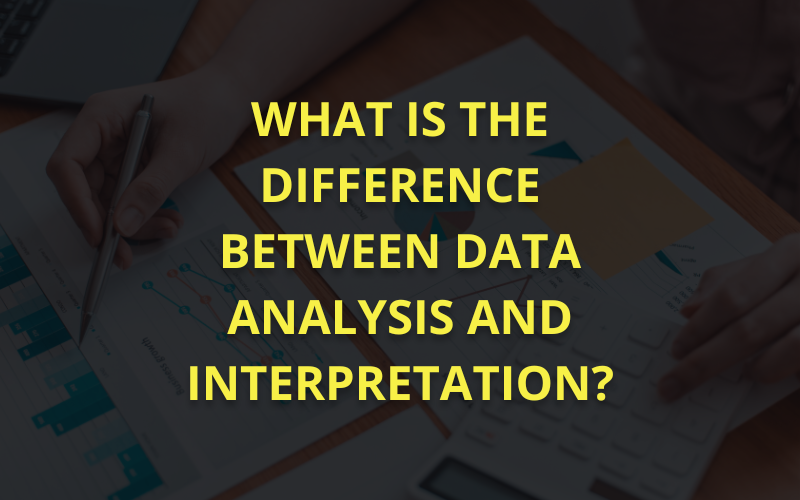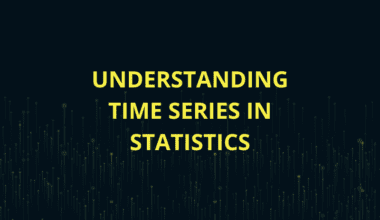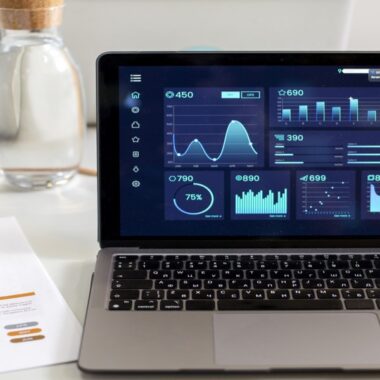Summary: Data Analysis and interpretation work together to extract insights from raw data. Analysis finds patterns, while interpretation explains their meaning in real life. Understanding their differences ensures better decision-making. Overcoming challenges like data quality and bias improves accuracy, helping businesses and researchers make data-driven choices with confidence.
Introduction
Data Analysis and interpretation are key steps in understanding and making sense of data. Data Analysis involves organising and examining data to find patterns or trends, while data interpretation focuses on explaining what those patterns mean in real life. Both are essential for making informed decisions in business, healthcare, or everyday life.
This blog will explore the difference between Data Analysis and interpretation, helping you understand how each contributes to a clearer data picture. By the end, you’ll better grasp how both processes work together to guide effective decision-making.
Key Takeaways
- Data Analysis organises and examines raw data to identify patterns and trends.
- Data interpretation explains patterns and provides real-world meaning to the analysis.
- Both processes are crucial for informed decision-making in various industries.
- Challenges like poor data quality and bias can impact accuracy.
- Combining both ensures better insights and data-driven strategies for businesses.
What is Data Analysis?
Data Analysis is the process of examining, cleaning, transforming, and organising raw data into meaningful insights. It helps individuals and businesses make informed decisions by identifying patterns, trends, and relationships in the data. Simply put, Data Analysis turns data into information that can drive action.
Methods and Tools Used in Data Analysis
Several methods are used in Data Analysis, ranging from simple techniques to more complex approaches. Some common methods include:
- Descriptive Analysis: This method involves summarising and describing the main features of a dataset. It helps provide an overview of the data, such as average sales or total revenue.
- Diagnostic Analysis: This method is used to understand the reasons behind specific trends or events. For example, if sales drop, diagnostic analysis helps find out why.
- Predictive Analysis: This approach uses historical data to predict future outcomes, such as forecasting future sales based on past data.
- Prescriptive Analysis: This method suggests the best action based on the Data Analysis. For instance, it may recommend strategies to increase sales or reduce costs.
Various tools are used to carry out these analyses. Some of the popular ones include:
- Excel: A basic yet powerful tool for organising and analysing data.
- Tableau and Power BI: Visual tools that help present data in interactive charts and dashboards.
- R and Python: Programming languages for more complex statistical analysis and Machine Learning tasks.
Key Objective of Data Analysis
The main goal of Data Analysis is to extract valuable insights that can guide decisions and actions. By analysing data, businesses can identify growth opportunities, detect problems early, and improve their overall performance. For example, Data Analysis can help a company understand customer behaviour, optimise marketing strategies, or predict future demand for a product.
The Data Analytics market has seen significant growth in recent years. Valued at USD 41.05 billion in 2022, the market is expected to expand to USD 51.55 billion in 2023 and reach USD 279.31 billion by 2030.
This growth reflects the increasing importance of Data Analysis in all sectors, with a compound annual growth rate (CAGR) of 27.3% from 2023 to 2030.
What is Data Interpretation?
Data interpretation is the process of making sense of the results derived from Data Analysis. While Data Analysis focuses on organising and processing raw data to find patterns, data interpretation is about understanding those patterns and giving them meaning in real-world contexts.
In simple terms, it’s the step where the data is used to tell a story or draw conclusions that can guide decisions.
Role of Context and Insights in Data Interpretation
The context in which data is interpreted is crucial. Without context, the same data could lead to entirely different conclusions.
For example, a rise in sales might seem optimistic at first glance, but if the cost of production has also increased significantly, it might not be as favourable as it looks. Insights from the data and knowledge of the situation or environment help make sense of these patterns.
Data interpretation is not just about numbers; it’s about understanding the bigger picture. For instance, a business could analyse customer data to identify patterns in buying behaviour, but interpreting that data requires an understanding of market trends, seasonality, and even economic conditions to make accurate predictions or decisions.
Key Objective of Data Interpretation
The main goal of data interpretation is to extract actionable insights that can inform decisions. After analysing data, the objective is to answer the “why” and “what now” questions. Data interpretation helps identify the meaning behind trends and relationships in the data, leading to better decision-making.
For instance, in the field of genomic research, data interpretation plays a vital role. The global genomic Data Analysis and interpretation market, valued at USD 1.19 billion in 2024, is projected to grow significantly, reaching USD 2.96 billion by 2033, with a compound annual growth rate (CAGR) of 10.61% from 2025 to 2033.
This growth shows the increasing need for interpreting complex biological data to drive advancements in healthcare and personalised medicine.
Key Differences Between Data Analysis and Data Interpretation
When dealing with data, it’s essential to understand the difference between Data Analysis and interpretation. While both processes are essential for making sense of information, they serve distinct purposes and use different approaches. Let’s break down the key differences:
Focus: Quantitative vs. Qualitative
Data Analysis is primarily quantitative. This means it deals with numbers, measurements, and statistics. The goal is to organise and examine data to find patterns or trends. For example, counting how many people purchased a product or measuring the average temperature over time. It’s about what the data shows.
On the other hand, data interpretation is qualitative. It involves understanding the meaning behind the numbers or facts gathered during Data Analysis. For example, interpreting customer feedback to understand the reasons behind the purchasing behaviour. Data interpretation answers why the data behaves in a certain way.
Process: Methodical vs. Subjective
The process of Data Analysis is methodical. It follows a structured approach using tools and techniques to collect, clean, and analyse data. It’s all about ensuring accuracy and consistency. For instance, if analysing sales data, the process may include organising the data into tables, running calculations, or creating graphs.
In contrast, data interpretation is subjective. It involves using knowledge, experience, and intuition to conclude the data. Different people might interpret the same data slightly differently because it’s influenced by their understanding of the context or their perspective on the subject matter.
Outcome: Patterns vs. Conclusions
The outcome of Data Analysis often consists of patterns. It reveals relationships or trends that exist in the data. For example, identifying a seasonal sales spike or a downward customer satisfaction trend.
Meanwhile, data interpretation leads to conclusions. It helps make sense of the patterns discovered in the analysis. For example, interpreting that the sales spike occurs during holidays or concluding that poor customer satisfaction is due to a product defect.
Understanding these differences makes it easier to see how Data Analysis and interpretation work together to make data-driven decisions.
Challenges in Data Analysis and Interpretation
Data Analysis and interpretation are crucial steps in understanding information, but they come with challenges. These challenges can make it difficult to draw accurate conclusions or make the best decisions. Let’s look at some of these common challenges and how to tackle them.
Data Quality Issues
One of the biggest hurdles is poor data quality. Inaccurate, incomplete, or outdated data can lead to incorrect analysis and misinterpreting results. This problem can occur in both small and large datasets.
Overwhelm by Too Much Data
Sometimes, there’s just too much data to work with, making it hard to find what’s essential. Without proper filtering, the noise can drown out the relevant insights.
Bias in Interpretation
Data can be interpreted in various ways, and personal biases may cloud judgment, leading to misleading conclusions. This is especially true when no clear context or framework exists for interpreting the data.
Strategies to Overcome These Challenges
By addressing these challenges, Data Analysis and interpretation can become much more effective and insightful.
Ensure Clean and Reliable Data
Always check and clean the data before analysing it. Removing errors or filling in missing values can improve accuracy.
Focus on Key Information
Narrow down the data to focus on what truly matters. Use tools or methods to filter out unnecessary details.
Use Clear Frameworks for Interpretation
Apply structured methods to interpret data objectively, minimising bias. Consistency is key when making conclusions from the data.
Practical Examples
This section will look at simple examples to better understand the difference between Data Analysis and interpretation.
Example of Data Analysis
Imagine you are tracking the daily sales of a store for a month. Data Analysis involves organising and calculating the total sales daily, finding patterns, and spotting trends, like which days had the highest sales. It helps you understand what happened with the sales data.
Example of Data Interpretation
Now, data interpretation takes the analysed data and asks, “Why did sales peak on Fridays?” Maybe it’s due to a special promotion or weekend shopping habits. It provides meaning to the numbers and helps you make informed decisions.
Bottom Line
Data Analysis and interpretation are essential for making sense of information and driving informed decisions. While Data Analysis focuses on organising and examining raw data to identify patterns, data interpretation explains these patterns in real-world contexts.
Together, they help businesses and researchers extract actionable insights, improve strategies, and solve problems effectively. Understanding their differences ensures accurate decision-making while minimising errors caused by misinterpretation.
With the increasing importance of data in various industries, mastering both processes can enhance efficiency and lead to better outcomes. By combining quantitative analysis with qualitative insights, organisations can confidently make data-driven decisions.
Frequently Asked Questions
What is the Difference Between Data Analysis and Interpretation?
Data Analysis involves examining, cleaning, and organising data to identify trends and patterns. Data interpretation focuses on understanding these patterns in a real-world context to draw conclusions and guide decisions. Both processes help businesses and researchers make informed, data-driven decisions.
Why are Data Analysis and Interpretation Important?
Data Analysis and interpretation help businesses and researchers extract meaningful insights from raw data. They drive informed decision-making, improve efficiency, and reduce risks. Without analysis, data remains unstructured; without interpretation, data lacks context, making both processes essential for maximising value from data.
What are Common Challenges in Data Analysis and Interpretation?
Challenges include poor data quality, information overload, and bias in interpretation. Ensuring clean data, filtering relevant insights, and applying structured interpretation frameworks can overcome these issues. Addressing these challenges leads to more accurate and actionable conclusions from Data Analysis.




